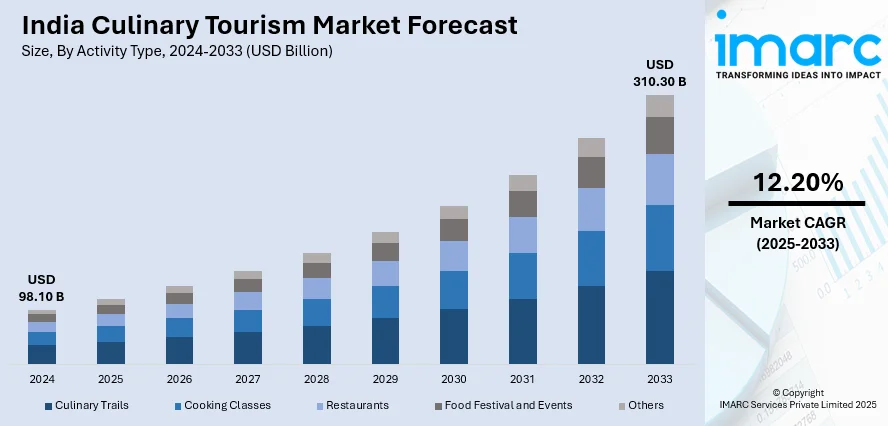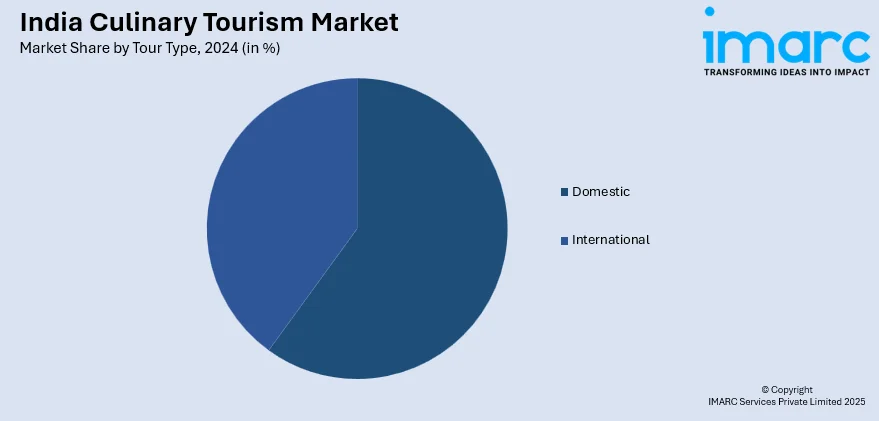
India Culinary Tourism Market Size, Share, Trends and Forecast by Activity Type, Tour Type, Age Group, Mode of Booking, and Region, 2025-2033
India Culinary Tourism Market Overview:
The India culinary tourism market size reached USD 98.10 Billion in 2024. Looking forward, IMARC Group expects the market to reach USD 310.30 Billion by 2033, exhibiting a growth rate (CAGR) of 12.20% during 2025-2033. The market growth is led by rising interest for regional and authentic dining experiences, rising disposable incomes, and social media influence. Also, tourism promotion initiatives by the government, increased global exposure to Indian cuisine, and using technology for individualized tourist experiences are the major drivers enhancing the India culinary tourism share.
|
Report Attribute
|
Key Statistics
|
|---|---|
|
Base Year
|
2024
|
|
Forecast Years
|
2025-2033
|
|
Historical Years
|
2019-2024
|
| Market Size in 2024 | USD 98.10 Billion |
| Market Forecast in 2033 | USD 310.30 Billion |
| Market Growth Rate 2025-2033 | 12.20% |
India Culinary Tourism Market Trends:
Rising Demand for Regional and Authentic Culinary Experiences
The significant shift towards regional and authentic food experiences is significantly supporting the India culinary tourism market growth. Travelers are increasingly seeking to explore the many regional specialties and ancient culinary traditions of India beyond the widely known food. States such as Kerala, Rajasthan, Punjab, and others are becoming prime destinations for foodies seeking to try authentic recipes, join cooking workshops, and meet the chefs themselves. This movement is propelled by a growing awareness of India's culinary diversity and the desire to have immersive food experiences. Social media and food blogs have also played a pivotal role in highlighting unique regional cuisines and inspiring travelers to embark on food-centric journeys. India is estimated to have over 900 million social media users by the year 2025, and the platforms with the highest number of users are WhatsApp (83%), Instagram (80.6%), and Facebook (71.7%). The average time spent by individuals in India on social media is 2 hours and 30 minutes a day, hence making it one of the most sought-after platforms for increasing awareness among the consumers. As a result, tour operators and hospitality providers are curating specialized culinary tours, offering farm-to-table experiences, and organizing food festivals to cater to this demand.

To get more information on this market, Request Sample
Rise of Fusion Cuisine and Innovative Food Experiences
The increase in demand for fusion cuisine and innovative food experiences is creating a positive India culinary tourism market outlook. Culinary chefs and restaurant owners are blending time-honored Indian flavors with international cooking techniques to create unique plates that entice both local and foreign guests. Pop-up eateries, themed dining experiences, and avant-garde food fairs are giving travelers chances over the next year to indulge in the imaginative and the avant-garde. Specialized culinary tourism sectors are growing as this trend is appealing to adventurous foodies looking for creative experiences. For instance, the rise of Korean culture, due to K-pop and K-dramas flooding the international market, has contributed significantly to the growth of Korean cuisine in India, with a staggering 162% rise in the consumption of Korean noodles in 2023. The popularity of fusión foods, including kimchi dosas and bulgogi tacos, is encouraging food services to serve K-food while blending the dish's invigorating flavors with Indian spices. There is a growing preference for Korean-inspired dishes, including creative offerings from culinary services that mirror India's changing culinary landscape. The fusion trend also reflects India's changing food culture, where tradition meets modernity in exciting ways.
India Culinary Tourism Market Segmentation:
IMARC Group provides an analysis of the key trends in each segment of the market, along with forecasts at the country level for 2025-2033. Our report has categorized the market based on activity type, tour type, age group, and mode of booking.
Activity Type Insights:
- Culinary Trails
- Cooking Classes
- Restaurants
- Food Festival and Events
- Others
The report has provided a detailed breakup and analysis of the market based on the activity type. This includes culinary trails, cooking classes, restaurants, food festival and events, and others.
Tour Type Insights:

- Domestic
- International
A detailed breakup and analysis of the market based on the tour type have also been provided in the report. This includes domestic and international.
Age Group Insights:
- Baby Boomers
- Generation X
- Generation Y
- Generation Z
The report has provided a detailed breakup and analysis of the market based on the age group. This includes baby boomers, generation X, generation Y, and generation Z.
Mode of Booking Insights:
- Online Travel Agents
- Traditional Agents
- Direct Bookings
A detailed breakup and analysis of the market based on the mode of booking have also been provided in the report. This includes online travel agents, traditional agents, and direct bookings.
Regional Insights:
- North India
- South India
- East India
- West India
The report has also provided a comprehensive analysis of all the major regional markets, which include North India, South India, East India, and West India.
Competitive Landscape:
The market research report has also provided a comprehensive analysis of the competitive landscape. Competitive analysis such as market structure, key player positioning, top winning strategies, competitive dashboard, and company evaluation quadrant has been covered in the report. Also, detailed profiles of all major companies have been provided.
India Culinary Tourism Market News:
- January 21, 2025: The Association of Hotels and Restaurants (AHAR), aims to position Mumbai as the Culinary Capital of India by 2030 under its "Mitra Concept", aligning with the global recognition of India's culinary excellence. It presented 50 milestones that will help improve the culinary landscape of the city and promote culinary tourism in the country. AHAR, with a membership of over 8,000, is undertaking initiatives like chef training, promotion of traditional cuisines, and food safety programs, including 100 FOSTAC sessions benefitting 4,000 restaurants.
India Culinary Tourism Market Report Coverage:
| Report Features | Details |
|---|---|
| Base Year of the Analysis | 2024 |
| Historical Period | 2019-2024 |
| Forecast Period | 2025-2033 |
| Units | Billion USD |
| Scope of the Report |
Exploration of Historical Trends and Market Outlook, Industry Catalysts and Challenges, Segment-Wise Historical and Future Market Assessment:
|
| Activity Types Covered | Culinary Trails, Cooking Classes, Restaurants, Food Festival and Events, Others |
| Tour Types Covered | Domestic, International |
| Age Groups Covered | Baby Boomers, Generation X, Generation Y, Generation Z |
| Modes of Booking Covered | Online Travel Agents, Traditional Agents, Direct Bookings |
| Regions Covered | North India, South India, East India, West India |
| Customization Scope | 10% Free Customization |
| Post-Sale Analyst Support | 10-12 Weeks |
| Delivery Format | PDF and Excel through Email (We can also provide the editable version of the report in PPT/Word format on special request) |
Key Benefits for Stakeholders:
- IMARC’s industry report offers a comprehensive quantitative analysis of various market segments, historical and current market trends, market forecasts, and dynamics of the India culinary tourism market from 2019-2033.
- The research report provides the latest information on the market drivers, challenges, and opportunities in the India culinary tourism market.
- Porter's five forces analysis assist stakeholders in assessing the impact of new entrants, competitive rivalry, supplier power, buyer power, and the threat of substitution. It helps stakeholders to analyze the level of competition within the India culinary tourism industry and its attractiveness.
- Competitive landscape allows stakeholders to understand their competitive environment and provides an insight into the current positions of key players in the market.
Key Questions Answered in This Report
The culinary tourism market in India was valued at USD 98.10 Billion in 2024.
The India culinary tourism market is projected to exhibit a (CAGR) of 12.20% during 2025-2033, reaching a value of USD 310.30 Billion by 2033.
India's culinary tourism industry is propelled by rising domestic tourism, cultural interest, and an expanding interest in local cuisine. Food-based experiences are being promoted by state tourism authorities, while more developed transport infrastructure improves access. Millennials and Gen Z consumers especially have an affinity for experiential dining experiences. Social media and food influencers are also key drivers of destination-based food experience popularity.
Need more help?
- Speak to our experienced analysts for insights on the current market scenarios.
- Include additional segments and countries to customize the report as per your requirement.
- Gain an unparalleled competitive advantage in your domain by understanding how to utilize the report and positively impacting your operations and revenue.
- For further assistance, please connect with our analysts.
 Request Customization
Request Customization
 Speak to an Analyst
Speak to an Analyst
 Request Brochure
Request Brochure
 Inquire Before Buying
Inquire Before Buying




.webp)




.webp)












